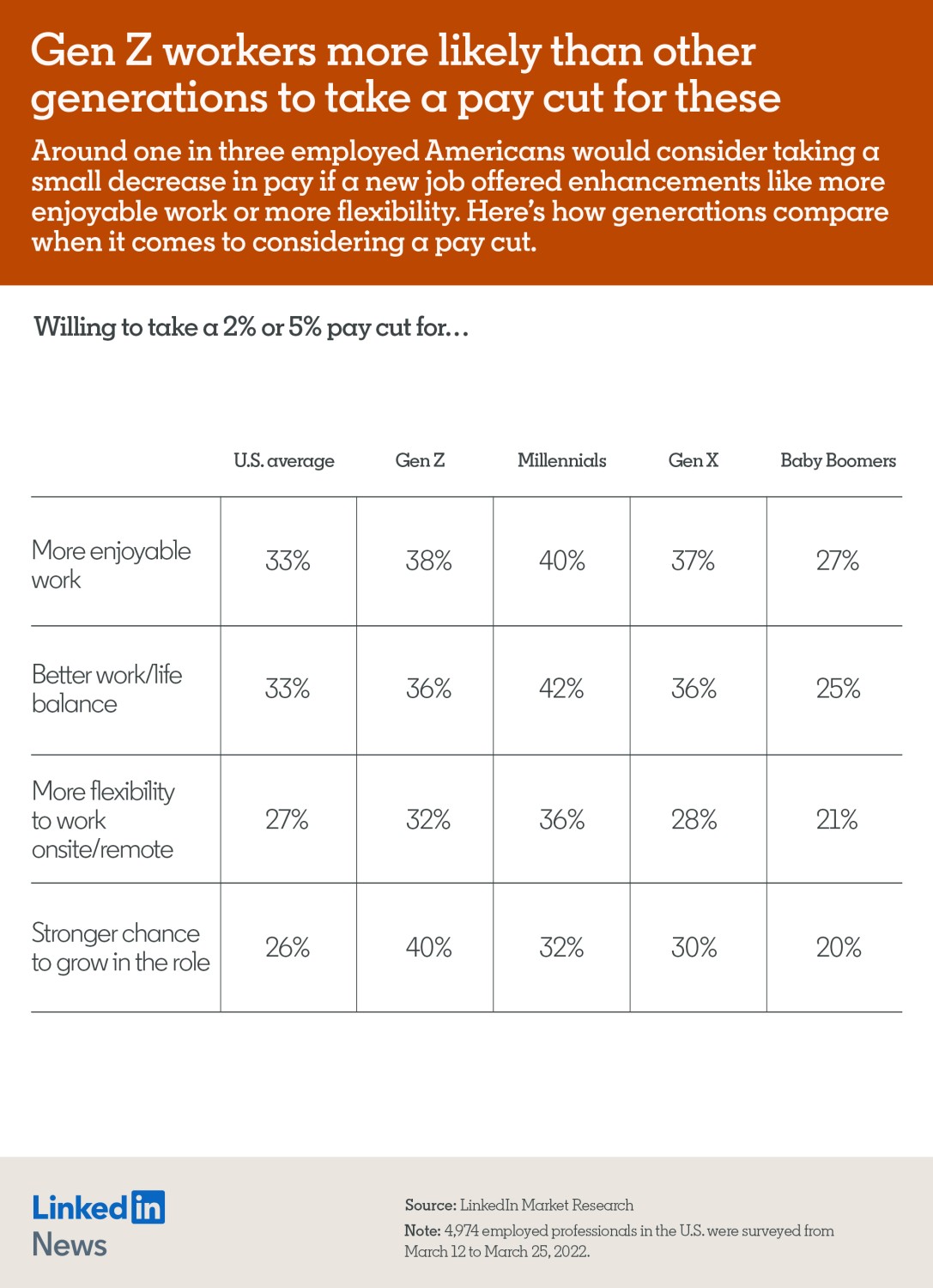
From Linked In: https://www.linkedin.com/pulse/more-imp ... ts-anders/
Better work-life balance. More interesting work. A stronger chance to grow in the job. Are those your distant dreams? Or are they absolutely crucial to you, right now?
If you’re wondering what the U.S. workforce really wants, the latest edition of LinkedIn’s Workforce Confidence survey raises the stakes by asking people how important eight non-financial goals are to them. Specifically, it asks: Would you switch jobs and take a pay cut to achieve any of them?
Some 46% of employed Americans said “No,” every single time. Their blunt message: Don’t touch my pay. Another 4% declined to answer. But half said they’d willingly trade away some money (2% or 5% of their current paycheck) — if a new job could upgrade their work lives in at least one vital direction.
Younger workers are most inclined to sacrifice money in pursuit of a better work environment, as seen in the chart below. That’s true for millennials (ages 25 to 40) and also for Gen Z (ages 24 or younger.), Gen X (ages 41 to 56) is in the middle; baby boomers (ages 57 and above) are most inclined to stick with what they’ve g
Better work-life balance. More interesting work. A stronger chance to grow in the job. Are those your distant dreams? Or are they absolutely crucial to you, right now?
If you’re wondering what the U.S. workforce really wants, the latest edition of LinkedIn’s Workforce Confidence survey raises the stakes by asking people how important eight non-financial goals are to them. Specifically, it asks: Would you switch jobs and take a pay cut to achieve any of them?
Some 46% of employed Americans said “No,” every single time. Their blunt message: Don’t touch my pay. Another 4% declined to answer. But half said they’d willingly trade away some money (2% or 5% of their current paycheck) — if a new job could upgrade their work lives in at least one vital direction.
Younger workers are most inclined to sacrifice money in pursuit of a better work environment, as seen in the chart below. That’s true for millennials (ages 25 to 40) and also for Gen Z (ages 24 or younger.), Gen X (ages 41 to 56) is in the middle; baby boomers (ages 57 and above) are most inclined to stick with what they’ve got.
In terms of the most tempting tradeoffs, surrendering cash in favor of “more enjoyable work” or “better work/life balance” ties for first place, connecting with 33% of employed Americans in both cases.
As for generational responses, millennials are the most committed toward better work/life balance. Many millennials now are juggling work obligations with parenting toddlers or school-age children. In dual-income households especially, the mantra of “two jobs; two kids; too little time” is hard to escape.
Beyond the strains of balancing career and parenting, millennials also may want to clear more time for the rest of life. In a recent Harvard Business Review article, management scholar Lauren Howe argues that side pursuits such as mountaineering or writing fiction can make employees more effective by boosting “a sense of empowerment and positive emotion.”
Flexibility to work onsite or remotely also is uniquely compelling to millennials. Some 36% of them are willing to take a pay cut here, the most of any generation.
Think of “flexibility” as the key word here. Controversies are flaring right now about the pros and cons of onsite, remote and hybrid work arrangements. The key takeaway: Each employee, industry and management team is likely to find its own equilibrium. We won’t all make the same choices.
How do you know what’s right for you? Wharton management professor Martine Haas has a handy five-step checklist, focusing on factors such as communication, coordination, connection, creativity and culture. Being candid about shortcomings and taking steps to fix them can help ensure better outcomes, she writes.
For Gen Z's members, the most tempting trade-off involves “a stronger chance to grow in the role.” 40% of them were willing to sacrifice some pay for such opportunities, well ahead of other generations’ 20% to 32% showings.
Give career starters credit for taking the long view. A lot of job-hopping early in people’s careers represents an attempt to find the best launchpad for ambitions that may stretch decades into the future. Turn the clock back and it’s likely that millennials, Gen X and even boomers took those risks in their early 20s. They’re just less inclined to do so now.
The Workforce Confidence survey offered three other potential scenarios for a pay cut, each of which connected with a somewhat smaller group of respondents across all ages.
The prospect of more inspiring company leadership won 21% support, while “a chance to be my whole self at work” resonated for 20% of employed Americans. At the bottom of the list was a “better relationship with my boss and/or team,” which was decisive for just 19%. Responses among the three younger generations didn’t vary significantly. Boomers were noticeably less interested in any of them.
Other attitudinal surveys, particularly by Gallup, have highlighted boss-related frustrations as a key reason why people switch jobs. But it may be in such situations, mistreated or mispositioned employees are able to bolt for higher pay. No need to take a pay cut when a different organization can see your full value more effectively.
What the Workforce Confidence survey does highlight is the importance of non-cash factors, such as enjoyable work, fulfillment and better work-life balance, in terms of how we all feel about our jobs.
Methodology
LinkedIn’s Workforce Confidence Index is based on a quantitative online survey distributed to members via email every two weeks. Roughly 5,000 U.S.-based members respond to each wave. Members are randomly sampled and must be opted into research to participate. Students, stay-at-home partners and retirees are excluded from analysis so we can get an accurate representation of those currently active in the workforce. We analyze data in aggregate and will always respect member privacy. Data is weighted by engagement level, to ensure fair representation of various activity levels on the platform. The results represent the world as seen through the lens of LinkedIn’s membership; variances between LinkedIn’s membership and the overall market population are not accounted for.
https://www.linkedin.com/pulse/more-imp ... ts-anders/
